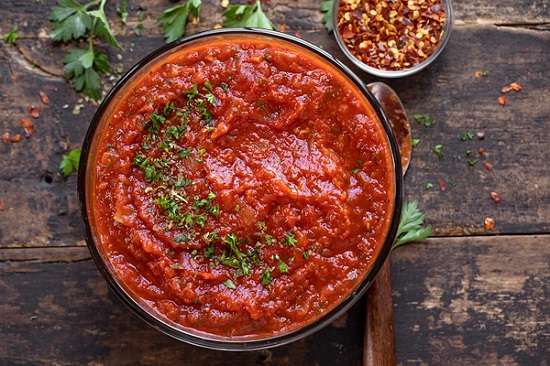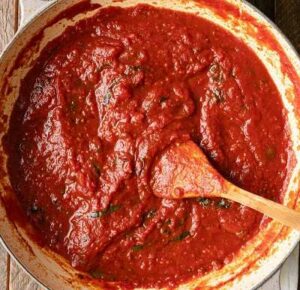Marinara sauce and spaghetti sauce are famous sauces that you can use on various dishes. However, they are made with different ingredients and have different flavors. In this blog post, we’ll look at the differences between marinara vs spaghetti sauce, so you can decide which one is right for you. Possibly the best sauce for side dishes, check it out here.
- What Is The Difference Between Marinara vs Spaghetti sauce?
- FAQ About the Marinara vs Spaghetti Sauce
- Is spaghetti sauce Italian?
- Can you use spaghetti sauce in place of marinara sauce?
- What is a marinara sauce made from?
- Where did marinara sauce originate?
- What is spaghetti sauce made from?
- Is marinara sauce gluten-free?
- Is spaghetti sauce gluten-free?
- Can you freeze spaghetti sauce?
- What is spaghetti sauce used for?
- What is a good marinara sauce recipe?
- Final Verdict
What is Marinara Sauce?
Marinara sauce is a tomato-based sauce that’s simple to prepare and typically served with vegetables. Unlike spaghetti sauce, marinara does not contain any meat or cheese and is very low in fat, which makes it the healthier option when cooking Italian food. Vegetables such as carrots, onions, garlic, celery, and more are added to create a bold and flavorful sauce that tastes fresh and light.
Marinara can also be used as a starting base for multiple Italian dishes. It’s often combined with other ingredients such as butter or olive oil, garlic, cheese, shrimp, clams, mussels, fish filets, meatballs, and more to create a unique dish.
Marinara Sauce

Marinara sauce is a classic Italian tomato sauce. The word marinara means “sailor-style,” as the first known written recipe for this sauce came from a cookbook called “L’Apicio Moderno” by Vincenzo Corrado in 1790.
He described a sauce made with tomatoes, garlic, oil, and parsley served with “any sort of fresh-water fish.” Today marinara is considered to be a basic tomato sauce. The ingredients in traditional Italian marinara sauce include:
- Olive Oil
- Garlic
- Onion or shallots if desired
- Crushed or diced tomatoes
- Spices such as basil, oregano, thyme, parsley, and marjoram
- Salt and pepper for taste.
You can use this sauce on pasta, meatballs, chicken Parmesan, or baked ziti. It’s also great in lasagna if you replace spaghetti sauce with it.
What is Spaghetti Sauce?
Spaghetti sauce is a tomato-based sauce rich in flavor and often includes meat or cheese. Some recipes call for bell peppers, onion, garlic, Italian seasoning, and tomatoes to create a robust dish.
The addition of these ingredients also provides you with a rich pasta sauce that perfectly compliments a heaping plate of spaghetti or your other favorite pasta.
Spaghetti sauce does not contain any cream and is made with abundant tomatoes to create a thick and hearty sauce. Some recipes you may find do call for adding heavy cream, but you should avoid those as they cut out the great nutritional value of traditional spaghetti sauce.
Spaghetti Sauce

The origin of spaghetti sauce is much different from that of marinara sauce. Spaghetti sauce, sometimes called “tomato gravy,” was created in America by Italian immigrants in the early 1900s.
The main difference between this tomato-based sauce and marinara is that it has a richer flavor due to additional ingredients such as:
- Ground beef, sausage, or pork
- Cheese such as Parmesan and mozzarella
- Butter or olive oil, often used for sautéing vegetables such as onions and garlic. This technique is known as “white sauce” in Italian cuisine.
- You can make spaghetti sauce with larger chunks of tomatoes.
What Is The Difference Between Marinara vs Spaghetti sauce?

The differences between marinara and spaghetti sauce are the ingredients used to make it, the flavors, and how they are used. Since marinara is a basic tomato-based sauce with fewer ingredients than spaghetti, it has a more robust flavor than spaghetti sauce.
This means that you can use marinara in place of traditional pasta sauces such as pesto, alfredo, or cheese sauces. Spaghetti sauce is a more decadent sauce that you can use in baked ziti and lasagna dishes.
The marinara sauce will come to mind when you think of Italian cuisine, while spaghetti sauce may not even cross your mind. Both sauces are delicious on pasta dishes or any dish that could use a tomato sauce. Spaghetti sauce is usually considered an American-Italian dish, while marinara is a very traditional and authentic Italian.
There you have it! Marinara sauce is Italian, and spaghetti sauce may not even cross your mind when thinking about authentic Italian food. If you are looking for a rich pasta sauce with meat and cheese, spaghetti sauce may be the right choice. However, if you want a traditional and straightforward marinara sauce very popular in Italian cuisine, it’s the better option.
What’s better, spaghetti sauce or marinara sauce?
Each sauce has pros and cons, depending on what type of flavor you’re looking for in your dish.
Spaghetti sauce is richer due to the addition of meat and cheese, but the marinara sauce tastes fresher. Marinara also works well with vegetables and can be used in dishes such as lasagna. In addition, it’s lower in fat than spaghetti sauce due to the lack of meat and cheese.
Marinara Sauce Nutrition Facts
- Serving Size: 1 cup or 8 fl oz (240 ml)
- Calories per serving: 27
- Total Fat per serving: 0 g (0% DV)
- Saturated Fat per serving: 0 g (0% DV)
- Cholesterol per serving: 0 mg (0% DV)
- Sodium per serving: 282 mg (12% DV)
- Potassium per serving: 547 mg (15% DV)
- Carbohydrates per serving: 6.7 g (2% DV)
- Fiber per serving: 1 g (4% DV)
- Sugar per serving: 4.3 g (5% DV)
- Protein per serving: 0.8 g (2% DV)
The % daily value tells you how much the nutrition of a food serving provides to the everyday diet. Two thousand calories a day are used for public nutrition advice.
Spaghetti Sauce Nutrition Facts
- Serving Size: 1 cup or 8 fl oz (240 ml)
- Calories per serving: 42
- Total Fat per serving: 3 g (5% DV)
- Saturated Fat per serving: 0 g (0% DV)
- Cholesterol per serving: 2 mg (1% DV)
- Sodium per serving: 343 mg (14% DV)
- Potassium per serving: 244 mg (6% DV)
- Carbohydrates per serving: 3.3 g (1% DV)
- Fiber per serving: 0.3 g (1% DV)
- Sugar per serving: 2.8 g (3% DV)
- Protein per serving: 1.5 g (3% DV)
The % daily value tells you how much the nutrition of a food serving provides to the everyday diet. Two thousand calories a day is used for public nutrition recommendations.
As you can see, spaghetti sauce contains higher amounts of sodium and calories than marinara sauce. Cooking with these sauces will provide a healthy option for your next dish.
You may like: Ninja Foodi AG301 Vs AG302; Why You Should Go For AG301?
Also, consider 12 Ways of How To Clean a Flat Top Grill
Is it possible to make both sauces in the same way?
For the most part, you can make either sauce with the same essential ingredients. Only one difference must tell me noted when creating a marinara sauce.
You will need to blend your chopped tomatoes before cooking them. If you make spaghetti sauce, you can skip this step and continue with the recipe like normal.
FAQ About the Marinara vs Spaghetti Sauce
Is spaghetti sauce Italian?
Can you use spaghetti sauce in place of marinara sauce?
What is a marinara sauce made from?
Where did marinara sauce originate?
What is spaghetti sauce made from?
Is marinara sauce gluten-free?
Is spaghetti sauce gluten-free?
Can you freeze spaghetti sauce?
What is spaghetti sauce used for?
What is a good marinara sauce recipe?
Final Verdict
As you can see, marinara sauce vs spaghetti sauce is very similar. They both use tomatoes as the main ingredient, making them red sauces.
The primary difference is that marinara uses blended chopped tomatoes while spaghetti sauce does not blend the tomatoes before cooking them. If you want to create a quick and easy sauce with a slightly different flavor, spaghetti sauce may be your best option.
However, if you are looking for a less rich dish that contains the dish’s main ingredients in its complete form (tomatoes), marinara would be a better option.
There is no right or wrong answer here, and it depends on your preferences. Whichever you choose to use, be sure that the sauce’s main ingredients are tomatoes and oil or butter.